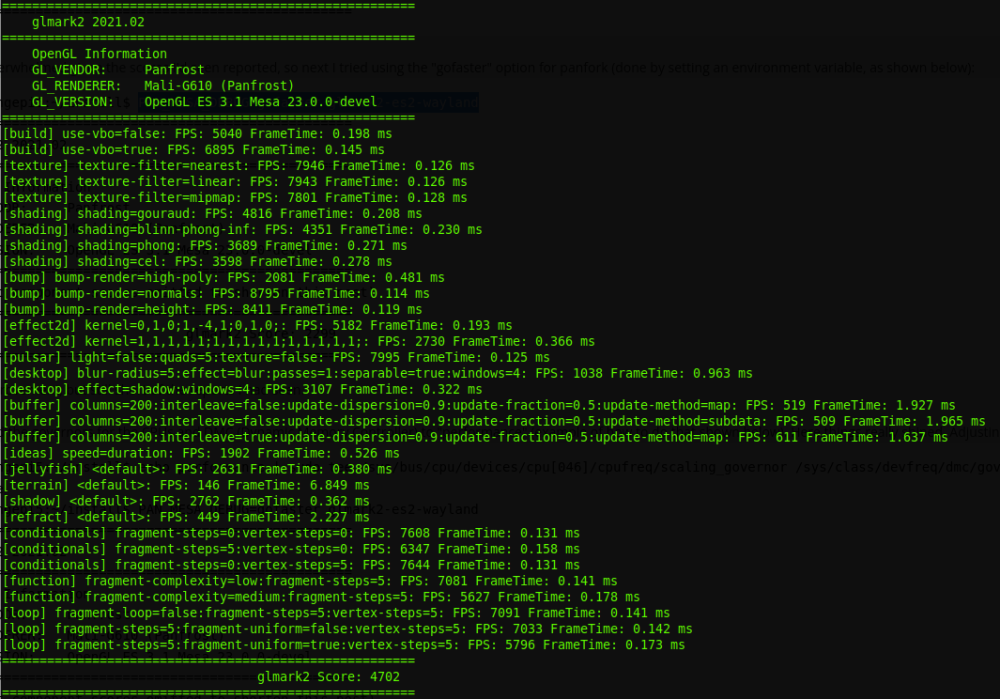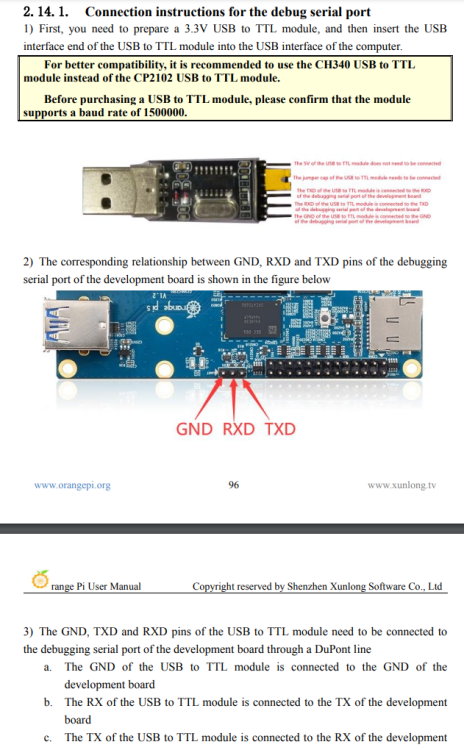
royk
Members-
Posts
259 -
Joined
-
Last visited
Content Type
Forums
Store
Crowdfunding
Applications
Events
Raffles
Community Map
Everything posted by royk
-
@ArmBoy1988 You don't need a boot partition, this is only on the image for the sd-card. The partition created for Armbian has to be the first partition and you should install the bootloader to MTD indeed.
-

armbian-install to NVME (Samsung 960 Pro) not working
royk replied to Peter Hauck's topic in Orange Pi 5
I'd once problems after setting the alignment to 4k after setting it back to 512 it did work as it should, although this was when I dd copied an image to the nvme so I don't know if it applies when you install it via armbian-install. https://carlosfelic.io/misc/how-to-switch-your-nvme-ssd-to-4kn-advanced-format/ -

[GUIDE] Kodi on Orange Pi 5 with GPU Hardware Acceleration and HDMI Audio
royk replied to adr3nal1n27's topic in Orange Pi 5
@Al.DYou could search these things with for example "apt search Kodi repo" Then: sudo apt install ..... For Kodi Matrix you would need to compile one with gles2 support, on the GitHub of Kodi you could find instructions. -
At least the PWM fan works fine with the thermal governor on step_wise. Are you sure that you've the overlay files in the right folder? Or did you also activate other overlays that use the same pin?
-
Perhaps this site will help: https://techwiser.com/fix-bluetooth-device-doesnt-auto-connect-in-linux/ Maybe you need to reset the keyboard since it's paired with macbook?
-
HDR10 does work under GBM, dolby vision isn't supported in Linux because it isn't open sourced and needs a license. (it does on a licensed android box) You could play dolby vision movies in GBM with panfork, but it won't play as HDR. With the Mali blob driver and without panfork mesa it does also play under Wayland (as SDR) On the site of LibreELEC you could find an explanation about dolby vision: https://wiki.libreelec.tv/configuration/4k-hdr#hdr
-
What is the output of "aplay -L" And please first follow some computer courses instead of making nonsense comments.
-
In gnome settings -> network -> settings wired -> identity -> choose mac -> set on permanent Or this config file might help: https://github.com/Joshua-Riek/ubuntu-orange-pi5/blob/main/overlay/usr/lib/NetworkManager/conf.d/10-override-wifi-random-mac-disable.conf
-
Those are microcontrollers. You probably would need to find the right way to communicate with it. I've seen there is some python code to communicate with the module but those are made for the RPI so'll need some adjustments. https://github.com/pedestrian0423/DW1000_Raspi_Python_library/tree/master Python gpio libraries for the Orange Pi 5: RPI.GPIO replacement: https://github.com/jer021/OPi.GPIO WiringPi: https://github.com/orangepi-xunlong/wiringOP-Python/tree/next For branch next and recursive: git clone --recursive https://github.com/orangepi-xunlong/wiringOP-Python.git --branch next I can't help you further, maybe someone else who has the module.
-
If you receive the same as you've sent and the cs pin is pulled down I would say there is nothing wrong with the overlay. You probably need to check the wiring/config to your Qorvo DWM1000. So the fixup is implemented in the overlay.
-
Do you have the following line in armbianEnv.txt? fdtfile=rockchip/rk3588s-orangepi-5b.dts
-
@gLush The fixup.scr seems like it's deprecated. At least in the repo of orange pi all lines are comment out: https://github.com/orangepi-xunlong/linux-orangepi/blob/orange-pi-5.10-rk3588/arch/arm64/boot/dts/rockchip/overlay/rk3588-fixup.scr-cmd The CS should be pulled low the moment it sends data, does it get pulled down during the internal loop test? Did you follow the test from the manual? and did you receive the same as the output? sudo spidev_test -v -D /dev/spidev4.1 spi mode: 0x0 bits per word: 8 max speed: 500000 Hz (500 KHz) TX | FF FF FF FF FF FF 40 00 00 00 00 95 FF FF FF FF FF FF FF FF FF FF FF FF FF FF FF FF FF FF F0 0D | ......@....▒..................▒. RX | FF FF FF FF FF FF 40 00 00 00 00 95 FF FF FF FF FF FF FF FF FF FF FF FF FF FF FF FF FF FF F0 0D | ......@....▒..................▒.
-
@gLush I don't have experience with spi on this device, but shouldn't you connect miso to miso and mosi to mosi? https://www.circuitbasics.com/how-to-set-up-spi-communication-for-arduino/ Sorry I didn't read it correctly, this was for the internal loop which did work. Not sure if it's helpful but firefly has some documentation about how to use the spi: https://wiki.t-firefly.com/en/ROC-RK3588-PC/usage_spi.html#drive-coding
-

[GUIDE] Kodi on Orange Pi 5 with GPU Hardware Acceleration and HDMI Audio
royk replied to adr3nal1n27's topic in Orange Pi 5
FYI with the master branch HDR is broken again after this commit https://github.com/xbmc/xbmc/pull/23116/commits/e278e3a4b990d5de7afe9642b6b39c7eeff999bb If you revert this, it will work again, a proper fix seems has to be done in the kernel. So if someone knows how this has to be done... -
-
The experience I had was that the quotes were needed to make it even boot. But it seems you did it right, perhaps the issue isn't edid related. You could compare the edid with the one when it's working and the one when it doesn't. I thought I saw somewhere in the orange pi os there was a script hdmi/dp related. You could try that image to see if that works, if it does you could copy that script. Another thing you could try as workaround is to use a hdmi dummy, you might need one that imitates a 1080p monitor.
-
@Straconis To be sure, do you get a result with: lsinitramfs /boot/initrd.img-5.10.110-rockchip-rk3588 | grep btt7.bin
-

Orange PI 5 doesn't boot after firmware update using ARMBIAN beta tool
royk replied to rogermm's topic in Orange Pi 5
@NiLace I literally gave you the page number, how hard can it be. In case you're not able to find a page number in a manual...... -
@Straconis what passworder wrote is that if he first plugged his monitor into the HDMI (not the usb-c adapter) then the lcd into the usb-c adapter. If @passworder will compare the edid when it's working with the edid when it's not working you might gonna see what's going wrong. A way to do this: sudo apt install edid-decode cat /sys/class/graphics/fb0/device/drm/card0/card0-HDMI-A-1/edid | edid-decode > edid-working.log cat /sys/class/graphics/fb0/device/drm/card0/card0-HDMI-A-1/edid | edid-decode > edid-not-working.log With the usb-c adapter it will probably be cat /sys/class/graphics/fb0/device/drm/card0/card0-DP-1/edid | edid-decode > edid-working.log cat /sys/class/graphics/fb0/device/drm/card0/card0-DP-1/edid | edid-decode > edid-not-working.log To make loading the edid work, you'll need to add the edid file to your initramfs, to do this: sudo cp /sys/class/graphics/fb0/device/drm/card0/card0-DP-1/edid /usr/lib/firmware/edid/waveshare.bin sudo nano /etc/initramfs-tools/hooks/edid.sh #!/bin/sh # Copy local EDID monitor description data # mkdir -p "${DESTDIR}"/lib/firmware/edid EDID_DATA=/usr/lib/firmware/edid/waveshare.bin if [ -f "${EDID_DATA}" ]; then cp "${EDID_DATA}" "${DESTDIR}"/lib/firmware/edid/ fi exit 0 sudo chmod +x /etc/initramfs-tools/hooks/edid.sh sudo update-initramfs -u sudo nano /boot/armbianEnv.txt extraargs="drm_kms_helper.edid_firmware=edid/waveshare.bin"
-

[GUIDE] Kodi on Orange Pi 5 with GPU Hardware Acceleration and HDMI Audio
royk replied to adr3nal1n27's topic in Orange Pi 5
@Dbosco Because you've installed the ansible of Martivo, you could try to edit the asound.conf to: /etc/asound.conf <confdir:pcm/dca.conf> defaults.pcm.dca.iec61937 1 Or: <confdir:pcm/dca.conf> defaults.pcm.dca.aes0 0x04 Then: sudo alsa-force-reload && pulseaudio -k pulseaudio -D in pulseaudio you should see a hdmi/dts device. Choose that device. I guess you already have this installed, but you could run: sudo apt install libswresample3 If this doesn't work, you could try to set pulseaudio back to hdmi stereo, then in kodi set the audio output to 2.0 and at passthrough options disable all formats except ac3 and enable ac3 transcoding You could also try these with alsa, so 6 options to try. I don't have other ideas at the moment, but will search further for hbr passthrough. -

[GUIDE] Kodi on Orange Pi 5 with GPU Hardware Acceleration and HDMI Audio
royk replied to adr3nal1n27's topic in Orange Pi 5
@Dbosco That will not work You shouldn't had to rm 90-pulseaudio.rules, I hope you only moved it instead of removing. What is in /etc/udev/rules.d/11-rockchip-multimedia.rules Be sure you've got in the file: /usr/share/alsa/cards/HDMI-OUT.conf # configuration for HDMI connection which just expose the # audio out device <confdir:pcm/hdmi.conf> HDMI-OUT.pcm.hdmi.0 { @args [ CARD DEVICE CTLINDEX AES0 AES1 AES2 AES3 ] @args.CARD { type string } @args.DEVICE { type integer } @args.CTLINDEX { type integer } @args.AES0 { type integer } @args.AES1 { type integer } @args.AES2 { type integer } @args.AES3 { type integer } type hw card $CARD } And in /usr/share/alsa/cards/aliases.conf the line: rockchip-hdmi0 cards.HDMI-OUT Then: sudo alsa force-reload && pulseaudio -k && pulseadaudio -D Then open pulseaudio volumecontrol: in "Configuration" only enable hdmi" set this on STEREO, then go to "Output devices" -> advanced and enable the passthrough functions Now you're able to passthrough dts and ac3, but not aac, dts-hd. This is why you could better set pulseaudio at 5.1/7.1 and let kodi the decoding do. Otherwise you could try ALSA, assuming you're running it on GBM: sudo nano /usr/share/wayland-sessions/kodi.desktop And change: Exec=kodi-standalone to: Exec=pasuspender -- env KODI_AE_SINK=ALSA kodi-standalone -

[GUIDE] Kodi on Orange Pi 5 with GPU Hardware Acceleration and HDMI Audio
royk replied to adr3nal1n27's topic in Orange Pi 5
@Dbosco This is probably because of the audio device naming rule, I think this is a copied broken fix. Try: sudo rm /etc/udev/rules.d/90-naming-audios.rules What Martivo has should work then. At least for eac3 ac3 and dts. With Alsa some other formats might work. dts-hd could only work with alsa, but it doesn't. I've no idea why yet. Some things I found: Intel had the issue that the channel mapping order was not right, rpi soundchip only accepts one format "IEC958_SUBFRAME_LE". I think for the moment pulseaudio works best because then kodi decodes the non supported passthrough audio and plays it as multichannel, this way you should be able to play all movies with multichannel audio. -

[GUIDE] Kodi on Orange Pi 5 with GPU Hardware Acceleration and HDMI Audio
royk replied to adr3nal1n27's topic in Orange Pi 5
@Dbosco Perhaps you didn't uninstall the version with support for RPI. Try to install libcec again with: cmake -DCMAKE_INSTALL_LIBDIR:PATH='lib/aarch64-linux-gnu' -DCMAKE_INSTALL_PREFIX:PATH='/usr' -DHAVE_LINUX_API=1 .. make -j8 && sudo make install For Kodi run "make clean" and your cmake command first before you run make again, otherwise it will make the config it made before -

[GUIDE] Kodi on Orange Pi 5 with GPU Hardware Acceleration and HDMI Audio
royk replied to adr3nal1n27's topic in Orange Pi 5
@Dbosco I guess by first compiling and install libcec without support for RPI. -
@passworder I think you need to force it to load the correct edid. You could try to copy the edid at the moment it's working to /lib/firmware/edid/ then add the boot arg and hope it works. So that should look something like: sudo cp /sys/class/graphics/fb0/device/drm/card0/card0-HDMI-A-1/edid /lib/firmware/waveshare.bin sudo nano /boot/armbianEnv.txt Then add a new line: extraargs="drm_kms_helper.edid_firmware=edid/waveshare.bin"


